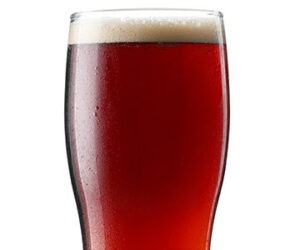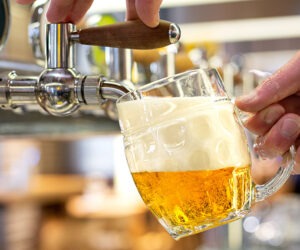American Brown Ale
Sometimes when we discuss a beer style, the facts and circumstances of its creation are well known, and other times we have mere speculation and story. Since this beer style was developed in my lifetime and I could speak to those involved directly, I thought this might have some historical value lest the story eventually get shrouded in myth and confusion.
Pete was a successful homebrewer working at a technology company in California when he co-founded his business (Pete’s Brewing Company) in 1986. He mentioned that he had won third place overall in a large California-wide homebrew competition with his beer, which he modeled off Samuel Smith’s Nut Brown Ale, but with some happy mistakes (like doubling the hops). He knew it wasn’t a clone of that beer, but that it was something new and delicious. Beer styles being immature at the time, he likely competed the beer in some kind of generic-sounding dark ale category.
When Pete wanted to brew commercially, he decided to outsource production through a contract brewing arrangement. Over the years, this led to his beers being produced in several different breweries across the United States with a reformulation each time to suit the local brewery while retaining a similar flavor profile. So when I asked Pete for “the recipe,” he just kind of laughed and said, “which one?” His beers were brewed at Palo Alto Brewing Company in California, Schells, Minnesota Brewing (old Schmidt brewery), and Strohs in Minnesota, then two Strohs plants in Washington and North Carolina. Each reformulation used the house yeast from each brewery, often at a higher fermentation temperature.
Pete’s Wicked Ale was their flagship beer the whole time. In 1998, Pete sold his company to Gambrinus, and continued to work for the company for two years. After Pete exited in 2000, Gambrinus reformulated the beer to taste more similar to Newcastle Brown Ale, a marked shift in flavor profile. This version was produced until 2011, when the brand was discontinued.
It’s hard to describe how influential Pete’s Wicked Ale was in the earlier days of craft beer (so early that it wasn’t called “craft beer” then — it was likely called “micro-brew”). Products like Samuel Adams Boston Lager, Sierra Nevada Pale Ale, and Anchor Steam dominated the market, with Pete’s Wicked Ale being the number two selling brand at its peak in the mid-1990s. The beer market imploded in the late 1990s and early 2000s before re-emerging in its current form as craft beer in the mid-2000s and continuing its growth until today.
So that’s a short history of Pete’s Wicked Ale, but what about the American brown ale style? If you look in beer books from the 1980s and 1990s, you’ll find very little mention of brown ale except as a traditional English style. Michael Jackson’s World Guide to Beer in 1977 talks about brown ales as being sweet and from the UK and the Netherlands. His New World Guide to Beer in 1988 mentions UK brown ales, but as a London-style dessert beer in the model of Mann’s. His Beer Companion in 1997 includes the north and south style divide, and describes Newcastle as the prototype of the northern style. He mentioned a hoppier American version but said he was, “not convinced they represent a distinct category.” He mentioned Pete’s Wicked Ale by name and said he tried it at the GABF in 1992 and 1995. The Brown Ale book (Daniels and Parker, 1998) has a footnote about Texas brown ale, with several examples and cites the Dixie Cup competition as a source.
From a competition standpoint, I asked Chris Swersey, the competition manager for the GABF, about the style. He said American brown ale was likely added in response to the popularity of Pete’s Wicked Ale, but that Charlie Papazian was the best source. So I asked Charlie about the style and he said it first appeared at the GABF as a style in 1992. He provided a photocopy of the style description that simply read, “American Brown Ales look like their English counterparts but have an evident hop aroma. Estery and fruity character should be subdued; diacetyl should not be present. Strong hop aroma.” He also suggested it may have appeared first in American Homebrewer Association (AHA) style guidelines.
The GABF style guidelines from 1991 mention a Texas brown ale with an OG of 1.040–1.055, 15–22 SRM, 4.5–6.5% ABV, and 25–60 (!) IBUs. The 1992 guidelines say that American brown had an OG of 1.040– 1.055, 4–5.5% ABV, 10–14 SRM, and 25–60 IBUs. The AHA references Texas brown ale in its 1989 national homebrew competition entry rules, but it could have existed earlier.
It seems like the guidelines were trying to reconcile two different beers, commercial beers like Pete’s Wicked Ale (29 IBUs) and homebrewed beers that could go above 50 IBUs. I was curious about the Texas brown ale variant used at the Dixie Cup competition, so I contacted Scott Birdwell of DeFalco’s Home Wine and Beer Supply, a Houston fixture since 1971. He said the style really went back to the early 1980s when he discovered them in Northern California at a homebrew shop owned by Byron Burch. They had a hoppy, roasty, dark, and bitter recipe called Purple Passion Dark Ale that was very popular with homebrewers but didn’t do well in competitions since they weren’t traditional English-style brown ales.
Scott described how he added a category called “California dark” to the then-new Dixie Cup competition for this style of beer. It was an immediate success, and the AHA picked up the category but renamed it (“curiously,” Scott says) to Texas brown ale. That eventually morphed into American brown ale in the AHA Style Guidelines. He also points out that modern American brown ales are more like slightly darker, slightly hoppier versions of English brown ales, more than those original beers (which he says were more typically 40 or more IBUs and at least 1.060 OG). He makes a good point that modern Black IPAs are likely a descendent (in flavor and balance, at least) of those original California dark beers since they share key similarities.
The Beer Judge Certification Program (BJCP) Style Guidelines of 1997 show influence from the AHA/GABF guidelines when they define the style as, “An adaptation by American homebrewers desiring higher alcohol and hop bittering levels to go along with the rich, malty character of all brown ales. Dark amber to dark brown color, medium body.”
In the 2004 and 2008 version of the BJCP guidelines, the American brown ale style was attempting to incorporate both the Texas brown ale and commercial American brown ale variants in one description. The 2015 BJCP Style Guidelines took the stronger, hoppier version and renamed it brown IPA (a type of Category 21B, Specialty IPA), while the American brown ale (Category 19C) version remains the common commercial version first popularized by Pete’s Wicked Ale. I find this fitting since the label for Pete’s Wicked Ale once proudly boasted that it was, “The Original American Brown Ale.”
While Pete’s Wicked Ale is only a memory at this point, two of my favorite examples of the style currently available are Big Sky Brewing Co.’s Moose Drool Brown Ale and Cigar City Brewing Co.’s Maduro Brown Ale.
SENSORY PROFILE
Not to be overly simplistic, but the name of the style provides most of the clues about its profile — it’s brown in color, it has ale qualities, and the ingredient choices reflect American characteristics. As with most American adaptations of traditional styles, the balance is more hoppy than the original as well.
The color of the beer should be some hue of brown (light to very dark), and the head shows that darker malts were used (off-white to tan color). There may be reddish or copper highlights that can give a mahogany impression. The beer should be clear, but darker versions are nearly opaque.
Malt and hops are both present in moderate (and noticeable) quantities, but the balance can vary quite a bit (although is often nearly even). The malt often has a caramel and chocolate flavor, perhaps nutty and toasty as well. The beer shouldn’t have a roasty character; it needs to not venture into the porter range. The specialty malts should give it color and flavor, so the flavors should deliver what the color promises.
The hop bitterness can be medium to medium-high, but complement the malty richness and/or sweetness. The flavors shouldn’t clash. The hop aroma and flavor should be noticeable and complementary, but doesn’t have to be overly aggressive. Remember that there is a brown IPA style for the larger and more hop-forward interpretations. The hops don’t have to be strictly American in profile (although that is traditional); continental or New World hops can be used as long as the result is balanced and pleasant.
The fermentation character for this style is neutral to somewhat fruity (moderate at most). Other fermentation by-products (such as diacetyl) are not desirable. The finish is medium to medium-dry so some residual sweetness is not a fault. This can also give the beer a medium to medium-full body. The brown IPAs are often drier than this, favoring the hops in the balance.
BREWING INGREDIENTS AND METHODS
The grain bill can vary greatly. At the very least, it should contain a base malt, a malt to add sweetness and caramel flavors, and a malt to give it color and deeper malt flavors. The classic combination is pale ale malt, crystal malt, and chocolate malt. Modern recipes can include additional flavor malts in the amber to brown range that can add complexity and flavor, but I personally would stick with American-origin malts to be traditional. For variety, I sometimes will use English or Belgian specialty malts but I would avoid overly bready or biscuity base malts such as Maris Otter.
The use of chocolate malt is interesting since that malt can provide different flavor contributions depending on its percentage of the grist. On the lower end, the malt can provide a nuttiness that is often associated with brown ales, while higher concentrations will provide a more noticeable chocolate flavor. Crystal malt in the 40 to 80 Lovibond range provides caramel flavors but also some darker fruit flavors. The crystal malt can be a fairly high percentage of the grist (up to 25%), which can provide quite a bit of malty sweetness.
While Pete says that a step mash was used in the original beer, a single infusion mash would also be appropriate for this style. I would mash on the lower end of the range (149 °F/65 °C) since the crystal malt will be providing body and residual sweetness.
Pete’s Wicked Ale used Brewers Gold and Cascade hops, with the Brewers Gold providing a spicy, fruity, and black currant character and the Cascade providing the bright, citrusy, and resiny character associated with many beers of the micro-brew era. Modern American or New World hops work well in this style.
I would shy away from classic English brewing hops since the style needs to distinguish itself from its British cousins. Dry hopping can add a fresh hop character. Modern versions can use other techniques (first wort hopping, whirlpool hopping, etc.) to emphasize the hop character as well.
A neutral to somewhat fruity American ale yeast can be used in this style, as can other yeast with a similar profile. Warm fermentation temperatures can help produce esters, if desired. The balance of esters with the specialty malt flavors gives the beer additional character that is suited to the style.
HOMEBREW EXAMPLE
My recipe below stays true to the information Pete provided about Pete’s Wicked Ale. Note that Pete said it was reformulated several times as production moved to different facilities, so it’s fine to tinker with the recipe to hit the desired flavor profile.
Pete said the recipe used pale ale malt, caramel 60 °L malt, and chocolate malt — all of US origin. He described different versions with the pale ale malt being 70 to 73% of the grist, crystal from 25 to 29%, and chocolate from 1 to 2%. I think nearly 30% crystal malt is pretty aggressive, but not unprecedented. At that level, the crystal malt will be driving much of the flavor of the beer and will require quite a bit of hops to balance. So I’ll use the low end of his crystal range and the high end of the chocolate.
The hops are Brewers Gold and Cascade, with bitterness and flavor additions with dry hopping. Pete said the boiling hops were 1⁄3 Brewers Gold and 2⁄3 Cascade, the flavor hops were all Brewers Gold, and the dry hopping 2⁄3 Brewers Gold and 1⁄3 Cascade. The flavor hops were a 5-minute addition, and the beer was hopped to 29 IBUs. The beer had an OG of 1.053 and was 5.1% ABV.
The recipe simply says “house yeast” so this likely changed from brewery to brewery. Kris England told me that Schell’s uses an altbier yeast as a house ale strain, so using something like White Labs WLP036 (Düsseldorf Alt) or Wyeast 1007 (German Ale) yeast would be appropriate. I think a neutral to slightly fruity American ale yeast would be fine too (US-05, Wyeast 1056, Wyeast 1272, WLP001, etc.). Pete’s notes say the beer was fermented warm, so I’ll use 68 °F (20 °C), which is warm for an alt yeast.
It’s been quite a while since I had the original beer, but it was one of those go-to beers when I was enjoying the micro-brew days. With so many new craft beer enthusiasts assimilating into the movement, I’ll bet that many beer drinkers today never had a chance to enjoy the original. Hopefully this will inspire a new generation of brewers as we rediscover historical gems.
My sincere thanks go to Pete Slosberg, Charlie Papazian, Chris Swersey, and Scott Birdwell for providing the first-hand historical recollections and notes used in this article.
BY THE NUMBERS
OG: 1.045–1.060
FG: 1.010–1.016
SRM: 18–35
IBU: 20–30
ABV: 4.3–6.2%
(5 gallons/19 L, all-grain)
OG = 1.053 FG = 1.015
IBU = 29 SRM = 23 ABV = 5.1%
INGREDIENTS
8 lbs. 3 oz. (3.7 kg) US pale ale malt
2.75 lbs. (1.25 kg) US crystal malt (60 °L)
4 oz. (113 g) US chocolate malt
4.6 AAU Cascade hops (60 min.) (0.66 oz./19 g at 7% alpha acids)
2.3 AAU Brewers Gold hops (60 min.) (0.33 oz./9 g at 7% alpha acids)
5.25 AAU Brewers Gold hops (5 min.) (0.75 oz./21 g at 7% alpha acids)
0.5 oz. (14 g) Cascade hops (dry hop)
1 oz. (28 g) Brewers Gold hops (dry hop)
Wyeast 1007 (German Ale), White Labs WLP036 (Düsseldorf Alt Ale), or SafAle K-97 yeast
3⁄4 cup corn sugar (if priming)
STEP BY STEP
On brew day, prepare your ingredients; mill the grains, measure your hops, and prepare your water. This recipe uses reverse osmosis (RO) water. Add 1⁄4 tsp. 10% phosphoric acid per 5 gallons (19 L) of brewing water, or until water measures pH 5.5 at room temperature. Add 1 tsp. calcium chloride (CaCl2) to the mash.
On brew day, mash in all the grains at 149 °F (65 °C) in 17 qts. (16 L) of water, and hold this temperature for 60 minutes. Raise the temperature by infusion or direct heating to 168 °F (76 °C) to mashout. Recirculate for 15 minutes. Fly sparge with 168 °F (76 °C) water until 6.5 gallons (25 L) of wort is collected.
Boil the wort for 75 minutes, adding the hops at times indicated in the recipe. After the boil, give the wort a long stir and let settle for 5 minutes. Chill the wort down to 68 °F (20 °C) and rack to the fermenter.
Oxygenate the wort, then pitch the yeast. Ferment at 68 °F (20 °C). After fermentation is complete, dry hop for 3 to 5 days. Rack the beer, prime and bottle condition, or keg and force carbonate
AMERICAN BROWN ALE
(5 gallons/19 L, extract with grains)
OG = 1.053 FG = 1.015
IBU = 29 SRM = 23 ABV = 5.1%
INGREDIENTS
5.5 lbs. (2.5 kg) light liquid malt extract
2.75 lbs. (1.25 kg) US crystal malt (60 °L)
4 oz. (113 g) US chocolate malt
4.6 AAU Cascade hops (60 min.) (0.66 oz./19 g at 7% alpha acids)
2.3 AAU Brewers Gold hops (60 min.) (0.33 oz./9 g at 7% alpha acids)
5.25 AAU Brewers Gold hops (5 min.) (0.75 oz./21 g at 7% alpha acids)
0.5 oz. (14 g) Cascade hops (dry hop)
1 oz. (28 g) Brewers Gold hops (dry hop)
Wyeast 1007 (German Ale), White Labs WLP036 (Düsseldorf Alt Ale), or SafAle K-97 yeast
3⁄4 cup corn sugar (if priming)
STEP BY STEP
Use 6 gallons (23 L) of water in the brew kettle; heat to 158 °F (70 °C). Steep the crystal and chocolate malt for 30 minutes, then remove.
Add the malt extract and stir thoroughly to dissolve the extract completely. You do not want to feel liquid extract at the bottom of the kettle when stirring with your spoon. Turn the heat back on and bring to a boil.
After the boil, give the wort a long stir and let settle for 5 minutes. Chill the wort down to 68 °F (20 °C) and rack to the fermenter.
Oxygenate, then pitch the yeast. Ferment at 68 °F (20 °C). After fermentation is complete, dry hop for 3 to 5 days. Rack the beer, prime and bottle condition, or keg and force carbonate.



